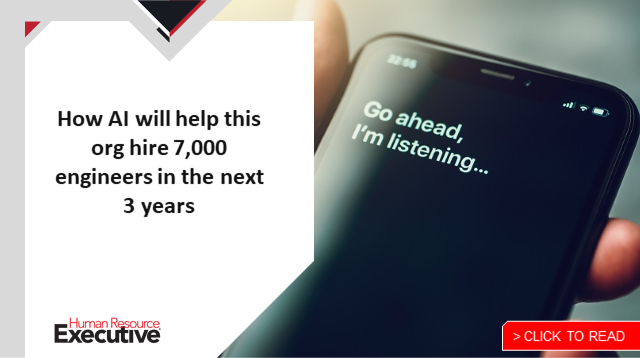Kyle Lagunas has achieved a talent trifecta: He has been a talent acquisition analyst, worked at TA solution provider Beamery, and spent the past 18 months as a practitioner at General Motors. At GM, he worked with a global team of 185 recruiting professionals who hired an estimated 10,000 employees in 2021. This month, Lagunas starts the next chapter in his career—as principal analyst for Aptitude Research, a TA market research firm based in the Boston area.

Lagunas, an HRE Top 100 HR Tech Influencer and thought leader in the recruitment space, recently sat down for an exit interview of sorts to discuss his tenure at GM, why burnout is very real, and what TA technology providers must deliver to overworked recruiters.
The following conversation has been edited and condensed for brevity and clarity.
HRE: Congrats on your new role. What made you accept this job after your time at GM?
Lagunas: [Aptitude Research CEO and founder] Madeline Laurano and I are long-time friends, confidants and co-advisers. When I started working as an analyst, she was the vice president of the research practice at Brandon Hall Group, a boutique HCM analyst firm. Madeline has been watching the talent tech market for longer than anyone and I learned quite a bit from her.
HRE: You have worked as an analyst, then for solution-provider Beamery and then you went to GM. Tell me about those moves.
Lagunas: I moved into General Motors where I was leading a major transformation initiative across their talent acquisition organization. I was figuring out what really happens on the practitioner side. [With this new role] I’m hoping that my skillset is going to power an insightful and compelling research agenda.
HRE: How would you characterize your tenure at GM? Did you experience burnout?
Lagunas: Absolutely. Burnout is rampant in recruiting and in HR, full stop. Look at the last three years of COVID: We thought it might be a two-week shutdown and then maybe the month after, things would return to normal. The last three years have been absolutely insane and I do not know how people have survived longer than I did.
 I have this privilege where I was brought in to help change drive change as only an outsider could because I had no preconceived notions of how things should be done. At the same time, that can be very disruptive and disruption is the last thing that these people want. They’ve been putting up with disruption for years.
I have this privilege where I was brought in to help change drive change as only an outsider could because I had no preconceived notions of how things should be done. At the same time, that can be very disruptive and disruption is the last thing that these people want. They’ve been putting up with disruption for years.
HRE: So it sounds like GM was not a toxic workplace, correct?
Lagunas: Oh my gosh, no. I have so much admiration for the HR organization and for the executive team. They are deeply and genuinely concerned about the right things, like being great corporate citizens, creating great candidate experiences and powering a fully electric fleet. It’s an incredible organization, but the Mary Poppins in me said, it’s time to go.
HRE: What did you learn as a talent acquisition practitioner that you didn’t expect when you started at GM?
Lagunas: We all know there are gaps between user adoption and vendor innovation because vendors are innovating way out here and users are somewhere else. What really surprised me was how many of our recruiters might embrace their gaps. They were ready to raise their hand and say, “Hey, I actually do not know what a CRM really is. Can you just spell it out for me?” But I could also see talent acquisition leaders do not have the capacity to spend a lot of time educating and evangelizing with their teams.
HRE: Because everyone is at the edge of burnout?
Lagunas: Exactly. It’s not just recruiters. It’s that I only have an hour this week to give to a topic and that includes my prep time for the meetings and planning sessions. There is just a complete gap in capacity for driving change. People aren’t anti-automation or worrying about robots taking their jobs. They were trying to understand how a robot or AI could help.
HRE: You and your team hired 10,000 employees in 2021?
Lagunas: Yes, and for this year, [when] we went into budgeting season for 2022, the number we were given for our hiring was a 40% increase, but we weren’t getting a 40% budget increase. It was like more pressure to scale our operating capacity with tech.
HRE: Do more with less, then?
Lagunas: Absolutely. I have so much empathy for the talent leader, the recruiter and the HR people now than I did before because I’ve sat down and had really difficult conversations with them about what we can do and what we can’t.
HRE: What’s your take on the current state of ATS and hiring recruitment technology?
Lagunas: I think that the ATS space is nearly fully mature and they understand the fundamental needs of what an ATS is supposed to do and what different organizations need it for. But the question that is running in my head is “whatever happened to the CRM?” I see no vendors going to market as CRM vendors anymore. They’re all talent intelligence platform, talent management, and lifecycle solutions, and they’re just trying to grow their use cases beyond candidate relationship management. We have been flooded with venture capital and private equity over the last five years and it has amplified the gap that already existed between innovation and utilization.
HRE: Can you give us an example?
Lagunas: I was collaborating with our head of talent operations on the RFP process for several different capabilities we needed at General Motors. We needed an AI matching and scoring solution, and then we needed a CRM and a new career website. We had to laser-focus the vendors that were bidding on just what we needed. We didn’t want presentations about roadmaps. We didn’t want to spend time on what was coming.
It was very difficult to keep those vendors focused, even though we were really bullish on the bidding process. We don’t want to look at what if; we wanted what is right.
 HRE: What are the primary roadblocks for today’s TAs? Is it outdated tech? Vague job descriptions?
HRE: What are the primary roadblocks for today’s TAs? Is it outdated tech? Vague job descriptions?
Lagunas: [Laughs] How much time do you have? It all comes down to capacity. Recruiting and TA teams have very limited capacity and very little time to optimize processes.
HRE: What will the next two years look like in the recruitment space? Will we see fewer vendors? More AI breakthroughs?
Lagunas: We will start to see organizations better utilizing AI and automation to augment their recruiting functions. Sometimes we just need something to help us close some of the gaps in our administrative processes to help things from falling through the cracks. The biggest opportunity we have going into a potential recession is looking at what we’ve bought and getting intelligent about optimizing these things. You started to see that during the beginning of COVID when talent operations teams said, let’s take this time to clean up our ATS. I really hope that that’s something that we can start to do if hiring slows down a bit.
Top 100 HR Tech Influencer Madeline Laurano will present the mega session “How the TA Technology Landscape Supports the Modern Recruiter” and appear on two other panels at next month’s 2022 HR Tech Conference. Register here.
The post What this TA vet learned from scaling up hiring at General Motors appeared first on HR Executive.